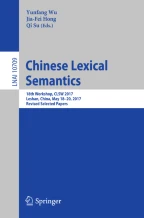Abstract
This paper deals with the polysemous words in noun compounds and investigates the relationship between their senses and the semantic types of the co-occurrent nouns. Taking “Zhongguo+N” as a studying case, we first review the senses of Zhongguo that are defined in Chinese Wordnet, WordNet and HowNet. Then we claim an innovative way of distinguishing the senses by integrating the semantic types based method and collocation based method. Afterwards, we focus on the noun compounds of “Zhongguo+N” and investigate the relationships between the semantic types of the collocating nouns and the different senses of Zhongguo. It turns out that the senses of the polysemous words are related to the semantic types of the co-occurrent nouns. In detail, the sense of culture highly relates to artificial objects, and the sense of location has more collocating nouns, while the sense of organization has the lowest frequency. These results show that the collocation information is the solid evidence for the sense distribution.
Access this chapter
Tax calculation will be finalised at checkout
Purchases are for personal use only
Preview
Unable to display preview. Download preview PDF.
Similar content being viewed by others
References
Reisinger J., Mooney R. J.: Multi-prototype vector-space models of word meaning. In Proceedings of NAACL 2010, 201: 109-117 (2010).
Pina L. N., Johnson R.: A Simple and Efficient Method to Generate Word Sense Representations. ArXiv preprint arXiv: 1412. 6045 (2014).
Wu, Y-F.: The Principles and Methods of Sense Discrimination for Chinese Language Processing, Applied Linguistics, 2 (2006). [In Chinese]
Wang, M.: Linguistic Knowledge Acquisition of Noun for the Construction of Probabilistic Lexical Knowledge-base. Ph.D. Dissertation, Peking University (2010). [In Chinese]
Wang, L-L., Wang M.: A Study on the Taxonomy of Chinese Noun Compounds. In proceedings of CLSW 2015 (2015).
Wei, X.: Research on Chinese Noun Compound Interpretation for Semantic-Query. Master Thesis. Peking University (2012). [In Chinese]
Cheng J-P., Wang Z-Y., Wen J-R., Yan J., Chen, Z.: Contextual Text Under-standing in Distributional Semantic Space. In Proceedings of CIKM 2015 (2015).
Kilgarriff, A.: I don’ t believe in word senses. Computers and the Humanities, 31: 91-113 (1997).
Blacoe, W., Lapata M.: A Comparison of vector-based representations for semantic composition. In Proceedings of EMNLP 2012, 546-556 (2012).
Wang, H.: A syntagmatic study on noun senses in contemporary Chinese. Peking University Press (2004). [In Chinese]
Author information
Authors and Affiliations
Corresponding author
Editor information
Editors and Affiliations
Rights and permissions
Copyright information
© 2018 Springer International Publishing AG
About this paper
Cite this paper
Wang, L., Wang, M. (2018). Disambiguating Polysemous Word Senses Based on Semantic Types and Syntactic Collocations: A Case Study of “Zhongguo+N”. In: Wu, Y., Hong, JF., Su, Q. (eds) Chinese Lexical Semantics. CLSW 2017. Lecture Notes in Computer Science(), vol 10709. Springer, Cham. https://doi.org/10.1007/978-3-319-73573-3_22
Download citation
DOI: https://doi.org/10.1007/978-3-319-73573-3_22
Published:
Publisher Name: Springer, Cham
Print ISBN: 978-3-319-73572-6
Online ISBN: 978-3-319-73573-3
eBook Packages: Computer ScienceComputer Science (R0)

